Seeds are nutrient powerhouses with the added ability to burn belly fat and assist with significant weight loss with very little effort on your part. Simply add a variety of the following seeds into your diet regularly and watch your waistline shrink.
Chia seeds, Flax seeds, Hemp seeds, Pumpkin seeds, and Sesame seeds are particularly conducive to weight loss. Each seed has a differing nutrient composition that provides a multitude of weight loss benefits. From regulating blood glucose to improving bowel function and regularity, seeds can give you an added boost in your metabolism to lose those extra pounds while reaping other health benefits in the process.
Let’s take a closer look at five seeds that have been shown to impact your waistline the most and how you can start incorporating them more regularly into your meals and snacks.
1. Chia Seeds
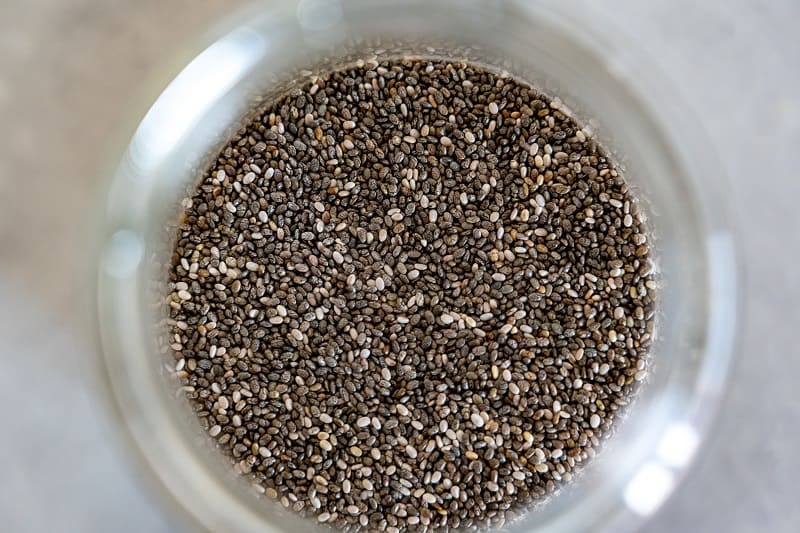
Coming in at number one for weight loss and its ability to burn belly fat are chia seeds.
While you can purchase this popular seed in its black or white form, the black chia seeds are much more abundant and thereby easier to come by.
This gluten-free seed helps to keep a nice lean body in a number of ways.
Why chia seeds assist with weight loss
This plant is known for its high fiber and antioxidant content. Chia seeds contain 50% more fiber than flax seeds!
Fiber promotes healthy gut flora which sends signals to the rest of your body to regulate metabolism and bowel function. These functions are necessary for the complex balance involved in weight maintenance.
Dietary fiber also acts as an appetite suppressant. After consuming a high fiber meal you will stay fuller longer while consuming fewer calories than you would have eaten with a low-fiber meal.
This is due to the zero calories contained in fibrous plant foods. The substance is indigestible. So it simply passes through the body to keep everything moving in the right direction while picking up toxins and other undesirable waste materials.
The seeds from the chia plant are also high in protein. Chia seeds contain more protein than oat, maize, rice, and barley seeds.
Protein is important for satiation. When consuming a meal deficient in protein you will likely become hungry long before it is time for your next meal.
Chia seeds are an excellent source of B vitamins such as folate, thiamine, riboflavin, and niacin. The high nutrient profile packaged inside these tiny seeds assist in appetite suppression.
When your body becomes deficient in micronutrients, such as those listed above, your stomach will begin sending signals to your brain to consume more calories in order to make up for the nutrient deficit.
What the science says
In 2017, 24 participants were tested to determine the mechanism behind chia’s weight loss benefits. The study showed that those who ate a snack containing chia seeds for breakfast reported having less hunger than the group that ate the same snack without chia seeds.
This effect resulted in fewer calories being consumed at lunchtime. Participants who consumed the chia seeds ultimately ended up eating fewer calories overall when compared to the control group who were not given the seeds.
This wasn’t a small reduction in overall calories consumed. This was a 25% reduction in calories consumed during the meal immediately following the chia snack.
The 25% reduction translated to an average of 300 fewer calories consumed during lunch.
One tablespoon of chia seeds is roughly 50 calories. A single serving is about two tablespoons.
Research also reveals an anti-inflammatory effect suggesting chia seeds may help reduce weight put on by runaway inflammatory responses.
There is a HUGE caveat, however, when it comes to using the chia plant to induce weight loss, particularly in the midsection.
It is crucial to grind the seeds prior to consumption. Without this preparatory step, the seeds will pass more easily through your body with little absorption.
The research is further explained in the video below by Dr. Michael Greger.
| Nutrient profile per serving | Quantity found in Chia Seeds |
|---|---|
| Total Calories | 109 |
| Protein | 4.4 g |
| Fat | 6.9 g |
| Monounsaturated Fat | .52 g |
| Omega-3 | 4 g |
| Omega-6 | 1.3 g |
| Iron | 2.2 mg |
| Calcium | 179 mg |
| Potassium | 115 mg |
| Fiber | 10.6 g |
How to incorporate chia seeds into your diet
Chia seeds are incredibly versatile. You can literally add them to any dressing or dish for added flavor or texture.
Chia pudding is another popular option. You just mix a couple tablespoons of chia seeds into your favorite soy based yogurt.
Some people prefer to add chia seeds to water, let it sit for at least ten minutes, then drink it plain. This is thought to help remove toxins from the body. As the mixture sits, it becomes thick and gelatinous.
2. Flax Seeds
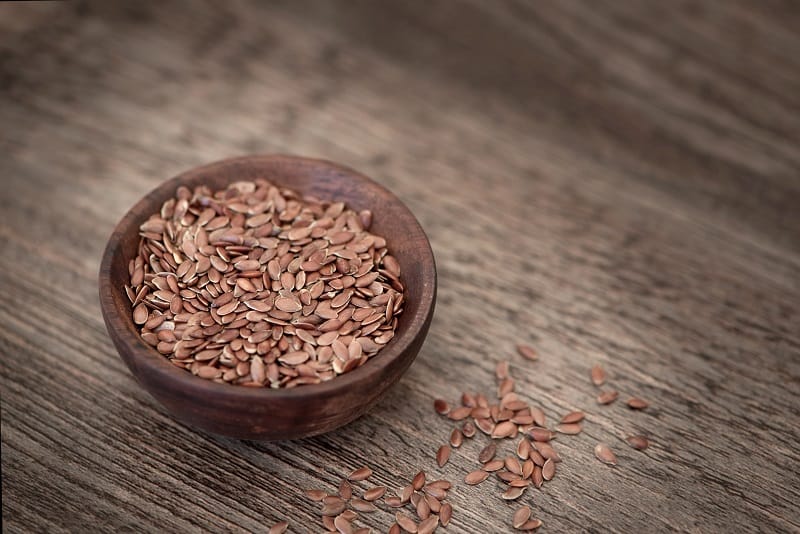
Flax seeds contain a wealth of nutritious compounds. As with chia seeds, flax require some form of grinding prior to consumption.
If you attempt to eat the seeds whole you will lose out on a great majority of the nutrients comprised within these tiny seeds. Milling, or grinding the seeds gives you access to nutrients otherwise protected by a strong outer wall.
Why flax seeds assist with weight loss
As with chia seeds, flax contains a number of different polyphenols that act as antioxidants in the body. Flax also has a significant amount of fiber which has been proven to support weight loss in a variety of scientific studies.
Flax is helpful in reducing cholesterol which is associated with weight gain and high blood pressure.
The high fiber contained in flax has been shown to regulate blood sugar. This allows for a much smoother release and acceptance of insulin into the cells.
Insulin has been deemed the “fat-storage hormone”. Foods deficient in fiber induce a large spike in insulin release, thereby leaving more insulin in the bloodstream than the cells are able to utilize.
Having too much insulin in the bloodstream results in fat storage. The high fiber in ground flax seeds significantly reduces the amount of fat that becomes stored in the body following a meal.
Flax seeds are only slightly lower than chia seeds when it comes to protein at 3 grams per serving. As mentioned above, sufficient protein is necessary for reducing appetite and maintaining a general feeling of fullness.
What the science says
Properties contained in flax seed have been proven to be significant cholesterol-lowering agents. This was shown in a study comparing milled flax seed to milled wheat.
Participants with peripheral artery disease receiving two tablespoons of ground flax per day revealed a considerable drop in circulating LDL cholesterol. These results began to appear within a single month of trial initiation.
LDL cholesterol is often referred to as the “bad cholesterol”. This is due to the tendency of this form of cholesterol to build up in your arteries.
With high cholesterol, you can develop fatty deposits in your blood vessels. Eventually, these deposits grow, making it difficult for enough blood to flow through your arteries.
Mayo Clinic
Another study revealed a significantly higher drop in metabolic syndrome measures in participants receiving four tablespoons of ground flax seed per day vs. those who did not. A greater reduction in insulin resistance was also observed in the flax group.
Body weight, waist circumference, and body mass index all decreased significantly more in the experimental group who received the flax.
The control group, those receiving no flax, lost an average of 7 lbs by the end of the trial, while the flax group lost an average of 20 lbs! This was accomplished all while receiving more calories per day than those who did not receive the flax!
View the video clip below for further details on these studies and more.
| Nutrient profile per serving | Quantity found in Flax Seeds |
|---|---|
| Total Calories | 75 |
| Protein | 3 g |
| Fat | 5.9 g |
| Monounsturated Fat | 1.05 g |
| Omega-3 | 3.2 g |
| Omega-6 | .8 g |
| Iron | 1 mg |
| Calcium | 24 mg |
| Potassium | 113 mg |
| Fiber | 3 g |
How to incorporate flax seeds into your diet
Flax can be used as an egg replacer in vegan or plant-based dishes. just mix 2-4 tablespoons of flax with water, let it sit for up to 10 minutes, then add it to the rest of the ingredients as usual.
I also use a lot of flax in my dips and dressings. The ground seeds provide a nice thick and creamy texture to an otherwise liquidy consistency.
Flax seeds are also tasty when mixed with oatmeal and other grains. They provide a nice nutty flavor.
3. Hemp Seeds
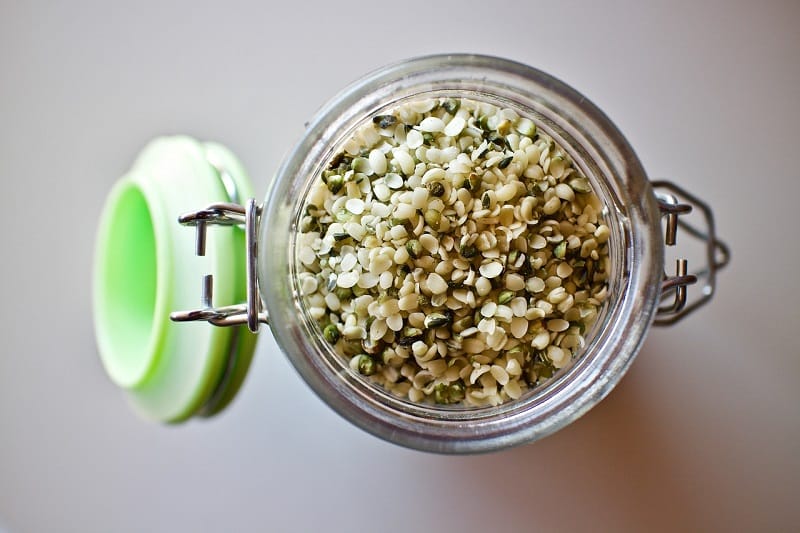
Hemp seeds are from the same species as cannabis (marijuana) but a different variety. They contain only trace amounts of THC, the psychoactive compound in marijuana.
Although related to the illicit substance marijuana, hemp is not a mind-altering plant. In fact, it is exceedingly nutritious in a variety of different ways.
Why hemp seeds promote weight loss
Hemp seeds contain more than 30% protein. Foods high in protein calories are shown to keep you feeling fuller longer, leading to fewer calories consumed overall throughout the day.
Hemp seeds are one of the few plants that provide complete protein sources, meaning they contain all the essential amino acids that your body can’t make.
Hemp seeds also contain gamma-linolenic acid, an important anti-inflammatory fatty acid. As mentioned above, foods proven to reduce inflammation are also helpful in promoting weight loss.
The high antioxidant profile found in hemp seeds are also powerful anti-inflammatory agents.
As with all seeds, whole hemp seeds are a good source of both soluble and insoluble fiber, containing 20% and 80%, respectively.
Soluble fiber feeds the beneficial bacteria found in your gut, regulates cholesterol levels, and levels out insulin spikes.
Soluble fiber is helpful for adding bulk to your stool, which supports colon and digestive health.
What the science says
Very little evidence exists on the remaining seeds covered in this article. But I will provide a short review of the existing information.
Hemp seeds have about a 3:1 omega-6 to omega-3 fatty acid ratio which is considered ideal. Some research suggests that hemp seeds may have a beneficial effect on heart health by increasing the amount of omega-3 fatty acids in the blood.
Due to the systemic nature of the human body, it is not unreasonable to infer that hemp seeds may impact lean body mass as a secondary component to the effect they pose on the heart. Clearly, more research is needed in this area.
| Nutrient profile per serving | Quantity found in Hemp Seeds |
|---|---|
| Total Calories | 113 |
| Protein | 6.7 g |
| Fat | 8.7 g |
| Monounsturated Fat | 1 g |
| Omega-3 | 1.7 g |
| Omega-6 | 5.3 |
| Iron | 2.7 mg |
| Calcium | 12.7 |
| Potassium | 222 mg |
| Fiber | .7 g |
How to incorporate hemp seeds into your diet
Hemp seeds can add extra nutrition to smoothies, stir fry, oatmeal, and many other plant-based dishes. Again, these are extremely versatile and subtle in flavor.
I like to add them to salad dressings as a natural thickener.
You can also add a couple tablespoons to top off sherbets and pudding.
4. Pumpkin Seeds
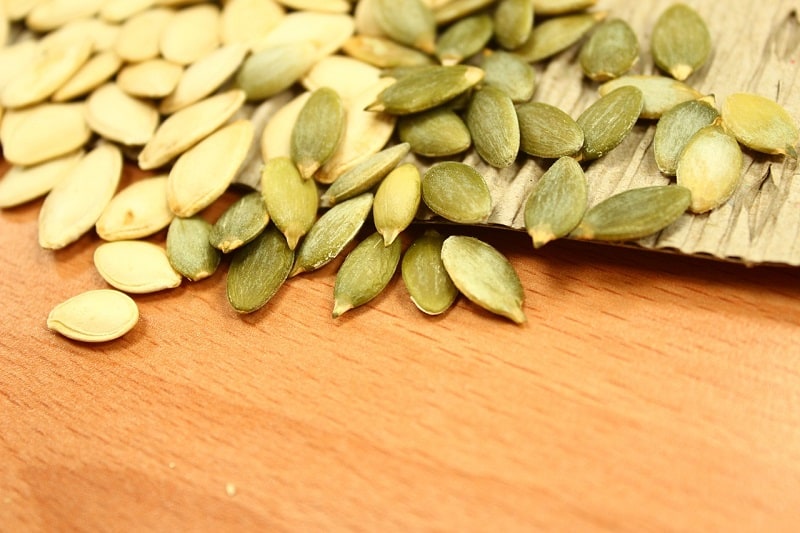
Pumpkin seeds are some of the most widely used seeds across the world. Their nutty flavor provides a versatile ingredient for many different cuisines.
These seeds are much larger than the others covered thus far in the article. They are typically measured by the ounce instead of tablespoons per serving.
Why pumpkin seeds promote weight loss
Pumpkin seeds have been shown to significantly regulate blood sugar. This allows for a steady dispersion of insulin across the cells, leaving little left over for the promotion of fat storage.
This type of seed is also helpful in the reduction of oxidative stress.
The body creates free radicals through a number of metabolic processes. Our environment also imposes free radicals on the body through toxic waste, pesticides, cigarette smoke, etc.
Free radicals ultimately lead to oxidative stress which inflicts cell damage across the body.
People with higher levels of free radicals tend to have a higher BMI (body mass index, waist circumference, and weight.
By keeping your exposure to harmful substances in the environment to a minimum and eating pumpkin seeds regularly, you can reduce your free radicals and ultimately, your waistline.
What the science says
Due to the high amount of fat found in pumpkin seeds, you would not expect them to be helpful for weight loss.
What the research shows, however, is that many of the fat calories pass through the system unabsorbed by the small intestine. This leads to fewer calories taken up by the body.
Overall, pumpkin seeds provide numerous weight-loss benefits, including blood-glucose regulation, high nutrient density, high satiety mechanisms, high in protein, fiber, antioxidants, and appetite suppression.
When you factor in the research finding that only a portion of the total calories are absorbed from the seeds, you are left with a significantly effective weight loss tool.
It is important to note that these weight loss mechanisms are only applicable when pumpkin seeds are consumed in moderation. Try not to exceed one ounce per day.
| Nutrient profile per serving | Quantity found in Pumpkin Seeds |
|---|---|
| Total Calories | 170 |
| Protein | 8 g |
| Fat | 13.9 g |
| Monounsturated Fat | 4.6 g |
| Omega-3 | .034 g |
| Omega-6 | 5.9 g |
| Iron | 2.6 mg |
| Calcium | 10 mg |
| Potassium | 240 mg |
| Fiber | 3 g |
How to incorporate pumpkin seeds into your diet
Pumpkin seeds are a bit larger in size, so they may need to be blended if you are trying to incorporate them into soups, dressings, or other similar consistency.
If you prefer to eat them in their natural form, I find them to be best on salads or mixed into granola and nut mixes.
For an easy trail mix you can combine any of the following ingredients:
- cacao nibs
- coconut flakes
- pumpkin seeds
- cashews
- almonds
- walnuts
- dried cranberries
- goji berries
- sunflower seeds
5. Sesame Seeds
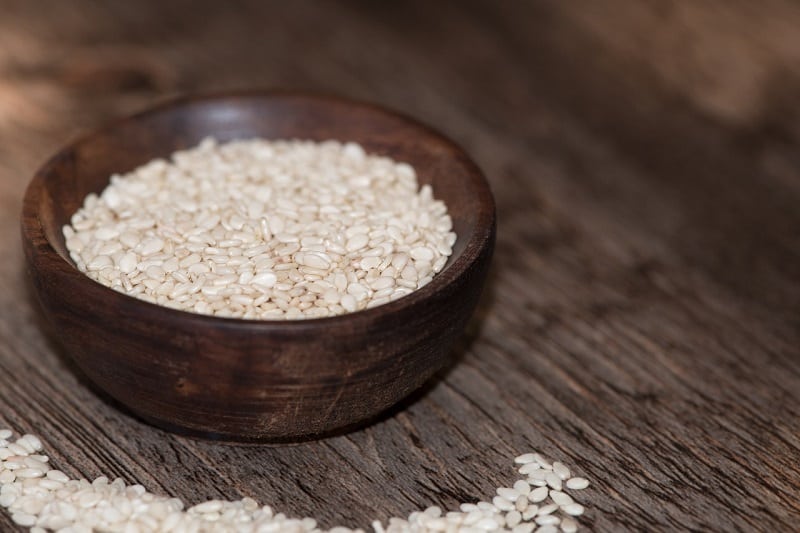
Sesame seeds are not only helpful for managing your weight, they also protect you against a number of chronic diseases, such as diabetes, heart disease, and arthritis.
These seeds have also been implicated for use in the treatment of hormone imbalances, and thyroid dysfunction. This tiny seed packs a powerful nutritional punch when consumed regularly.
Why sesame seeds promote weight loss
With twice as much protein per serving as flax seeds, sesame seeds have the calorie-burning advantage from this aspect. Sesame seeds provide a whopping 6 grams of protein with every two tablespoons consumed.
We have already discussed how protein curbs hunger and helps you to stay fuller longer. Both of which are very supportive in any efforts to lose weight.
As with the other seeds found on this list, sesame seeds are high in fiber, antioxidants, and B vitamins.
They have been shown to regulate glucose metabolism, stabilize blood pressure, and reduce oxidative stress throughout the body.
The omega-3 to omega-6 ratio is not as impressive as the ratio found in hemp seeds, but it is still beneficial for your health.
What the science says
Research on sesame seeds determine that they are powerful anti-inflammatory agents.
Steady, low-grade inflammation has been shown to play a key role in overweight and obesity.
Studies also show that the high antioxidants contained in sesame seeds assist in reducing plaque build-up in the arteries. This leads to lower blood pressure and greater blood flow throughout the body.
An increase in blood flow allows for more nutrients to be delivered and transported to cells, along with more efficient removal of waste products that may trigger fat storage hormones.
Other research suggests that sesame seeds lower cholesterol and triglyceride levels, both of which are highly associated with diseases that stem from being overweight or obese.
The cholesterol lowering mechanism is thought to be caused by the lignans and phytosterols found abundant in these plants.
| Nutrient profile per serving | Quantity found in Sesame Seeds |
|---|---|
| Total Calories | 180 |
| Protein | 6 g |
| Fat | 15 g |
| Monounsturated Fat | 5.4 g |
| Omega-3 | .1 g |
| Omega-6 | 6.2 g |
| Iron | 2 mg |
| Calcium | 328 mg |
| Potassium | 166 mg |
| Fiber | 5 g |
How to incorporate sesame seeds into your diet
Sesame seeds are usually located in the grocery stores as tahini. It’s like a sesame seed butter.
Tahini is used abundantly in hummus and homemade plant-based dressings.
My favorite salad dressing combines
- 2 Tbsp tahini
- 1 Tbsp maple syrup
- 2-4 Tbsp apple cider vinegar
- 1 1/2 cups of water
- garlic powder
- onion powder
- fresh ground pepper
You can also add sesame seeds on top of breads, bagels, and muffins.
Comparing Seed Composition
| Seed | Calories | Saturated Fat (g) | Protein (g) | Fiber (g) | Omega-3 (g) | Omega-6 (g) |
|---|---|---|---|---|---|---|
| Chia (2 Tbsp) | 109 | .75 | 4.4 | 10.6 | 1.3 | 4 |
| Flax (2 Tbsp ground) | 75 | .51 | 3 | 3 | .8 | 3.2 |
| Hemp (2 Tbsp) | 113 | 1 | 6.7 | .7 | 1.7 | 5.3 |
| Pumpkin (1 oz.) | 158 | 2.5 | 8 | 3 | .034 | 5.9 |
| Sesame (2 Tbsp) | 165 | 2 | 6 | 5 | .1 | 6.2 |

